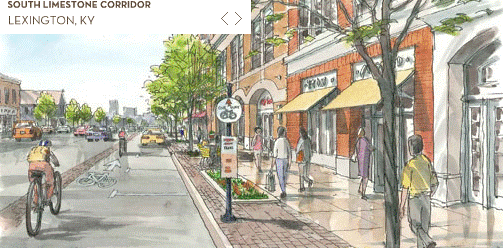The South Limestone streetscape project began with the closure of South Lime two months ago today, and the project is slated to continue for another 10 months. Meant to better connect downtown with the University of Kentucky campus, the project includes the widening of sidewalks, the installation of bike lanes, and the underground placement of utilities.
When the project started, we wrote about the chaotic process of closing the street and about the need for practical planning and design on South Lime and other urban development projects. How has the project evolved since then?
Not well.
Severed Artery
The closure dramatically impacted traffic patterns between downtown Lexington and the south side of our city, resulting in gnarled traffic on a number of alternative routes to downtown. At various points in the project, intersections with cross-streets (High, Maxwell, and Euclid) have also closed with little notice, adding to confusion and gridlock for downtown commuters and shoppers. In effect, the closure of South Limestone has walled off downtown from Lexington’s south side.
Several businesses along South Lime have struggled to cope with the substantial loss of customers and the physical disruption of their businesses. Last week, Joe Graviss, the owner of the McDonald’s on South Lime, pleaded with Lexington’s Mayor and Urban County Council to add extra shifts or more workers to speed the project.
City officials responded that extra shifts will not accelerate the project. The project’s manager noted that the city’s concrete supplier closed in the evenings and that local utilities were already providing personnel to assist with the location and relocation of utility lines. At one point, he admitted that he had no ideas for speeding the South Lime project along.
Vice Mayor Jim Gray – the CEO of Gray Construction and the only councilmember to oppose the project – countered the project manager’s claims. “It would be wise of us not to be extravagant in describing the difficulties of this project… With 2000 projects under my belt, I’ve never seen a project that couldn’t be improved or accelerated.”
At this point, most elected leaders and city bureaucrats seem unprepared to take significant action to accelerate the South Limestone streetscape project.
That’s because they have been thinking about the impacts of South Lime on the wrong scale.
Estimates on the price of the South Lime project vary, but the early $5.2 million estimate has ballooned to somewhere between $13.1 and $17 million. The newer, higher price was partly meant to help expedite the project.
But, as we’ll see in a moment, that price far underestimates the true cost of the project to our city, our economy, and to our future.
South Limestone’s closure is not a mere inconvenience – it is a severed artery that is bleeding the life from downtown. It demands an urgent response from our leaders. The cost to the city is too
dear to delay action, especially in this difficult economy.
Disruption: Anecdotes and Hard Data
A number of weeks ago, on the first day that the High Street intersection with South Lime was closed, I worked in my office and overheard two different customers from the south side of Lexington talk about the enormous problem of getting to our downtown shop – the confusion from suddenly closing the High Street intersection had made traffic especially difficult to decipher.
Then, we had an elderly customer from Nicholasville make an appointment for the next day, asking for directions on how to get to the shop with all of the construction. Concerned about getting lost, she decided to do a dry run the day before. After experiencing the jams, diversions, and delays, she called back and canceled her appointment.
Last month, I talked with another downtown business who is in our same industry. They were scratching their heads about why their August business “fell off a cliff”. I talked with them again last week, and their business was still much slower than usual.
Yesterday, a regular customer who owns a shop in Festival Market came into Lowell’s and opened the discussion with a flat “Business sucks”.
When I started hearing these anecdotes, I began to think that the impacts of the South Limestone closure extended far beyond South Lime. I wondered about the effects of South Lime as a customer deterrent for our business:
- How many of our customers come from the south side of Lexington?
- How many of those south-siders might have chosen to stay away from “the mess” downtown?
- What could that data tell us about the impacts to all of downtown Lexington?
And what I saw in the data was astounding and troubling:
- About 30% of our customers come from ZIP codes which would use Nicholasville Road (which turns into South Limestone) as the primary corridor to downtown
- Since July 22nd – the date of the closure – we have lost one third of the business we’d normally expect from those ZIP codes. By comparison, the rest of Lexington is relatively flat or growing.
- The net of this was a loss of 10% of our sales (and a much bigger hit to our profitability) directly attributable to the South Lime closure.
I disclose these facts not as a woe-are-we pity party, but as a fact-based assessment of how “the mess downtown” affects one downtown business. Our business is a relatively healthy, well-respected business with incredibly loyal customers (Last week, we won “Best Honest Mechanic” from Ace Weekly readers). And, still, the closure of South Limestone accounted for a loss of a full third of south-side customers.
Ripple Effects
Can we extrapolate from just one business to the whole of downtown? Not with any degree of certainty. But my conversations with other business owners make me believe that my business’ experience with the South Lime closure is not exceptional. Admittedly, not every downtown business is as impacted by traffic disruptions, but most are impacted in some fashion: lost customers, lost productivity, supply chain delays, etc.
Hard data for downtown Lexington is difficult to come by.
- Just how much of Lexington’s $11 billion economy takes place downtown?
- Which businesses depend upon the smooth flow of traffic? To what degree?
- How many of their customers / employees / suppliers come from the south side?
Depending on the assumptions used, the estimate of impacts to downtown can vary wildly. Our best “conservative” estimate? Downtown Lexington loses about $360,000 each business day that South Limestone is closed. (Depending on our assumptions, the estimates ranged between $275,000 and $600,000 each day.)
That translates to between $7.0 to $7.7 million in lost business every month, or between $84 and $92 million for the year-long duration of the South Limestone project. That’s around 700 to 1000 jobs which could evaporate from downtown Lexington, especially as the closure drags on.
Are these numbers absolute? Not by any means. But they do provide a ballpark idea of the true cost of the South Limestone project.
Much of the focus on the costs of South Lime have focused on either a) the direct taxpayer costs ($17 million) or b) the costs to businesses on South Lime. And while those South Limestone businesses deserve special attention for the degree this project impacts them, our estimates suggest that our leaders and our community have been thinking about ‘cost’ on the wrong scale. There is a much bigger, much more urgent cost which must be addressed.
The irony of South Limestone – as the cycle of lost customers, declining businesses, lower employment, and more lost customers continues – is that the project may well end up strangling the very downtown that the streetscape is meant to connect with.
Our leaders frequently assert the necessity of a vibrant, livable downtown. It is time for them to live up to their words.
With the South Limestone closure, they must now choose: Will they continue to choke off downtown from a significant portion of the city, or will they act with urgency and extraordinary effort to accelerate and improve the project?
Their actions now will determine whether the prediction from our Chaos post will come true:
“And the results of the chaos are easy to predict. Confused commuters and shoppers stay away from ‘the mess’ downtown. Downtown businesses die. And, after fits and starts, Lexington ends up with a beautiful street. To nowhere.”
Time to choose.



Well written. I was wondering how the north-side was fairing through this. I’m a property owner in the middle of the site, and I have had one business tenant move–I may not be able to get it rented until the job is completed–this will probably cost me around $10k.
To be fully accurate, you would need to assess how much the slow down in the economy may have slowed these businesses and back that out of the loss figure though you point is a good one and one that few if any of our elected leaders understand.
i am a business owner at the corner of maxwell and limestone . the last week our business has almost hit a complete stop . over the last few months my business has been BOOMING ! over a $1,000 in sales daily . since the complete closure of maxwell and limestone i havent hit 100 dollars in a single day . i do not think i will be able to last at this point . its very unfair . i have planned for the last 10 years to accomplish my business , taking every last step to make sure i could achieve my goals . its funny because i always figured the reason my business would fail would be because i did not work hard enough or the city was just not in need a shop like mine . i never thought the the city would be the reason i lose my dream
Pingback: To-Do List for Lexington: 7. Plan Well | CivilMechanics
Pingback: To-Do List for Lexington: 1. Get Real | CivilMechanics
Pingback: A Small Business Perspective on Jobs and Tax Cuts | CivilMechanics
Pingback: What presenting to LFUCG is like | CivilMechanics